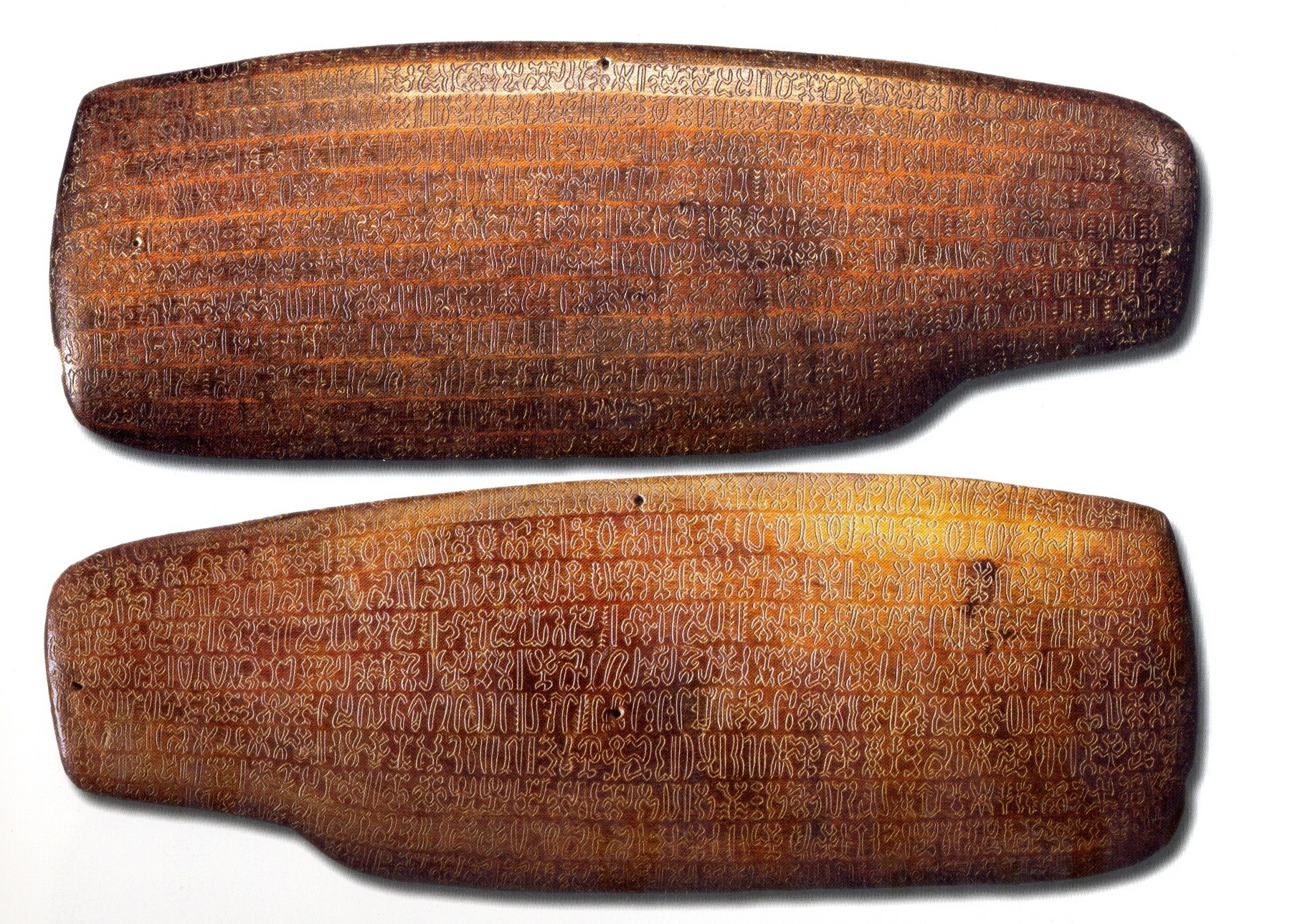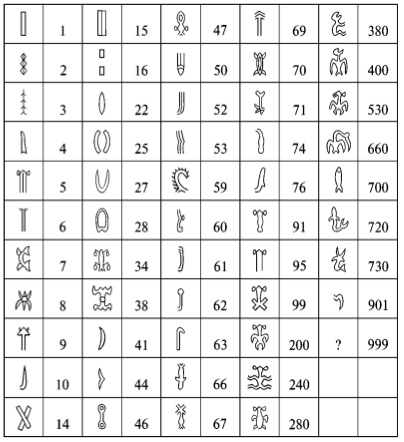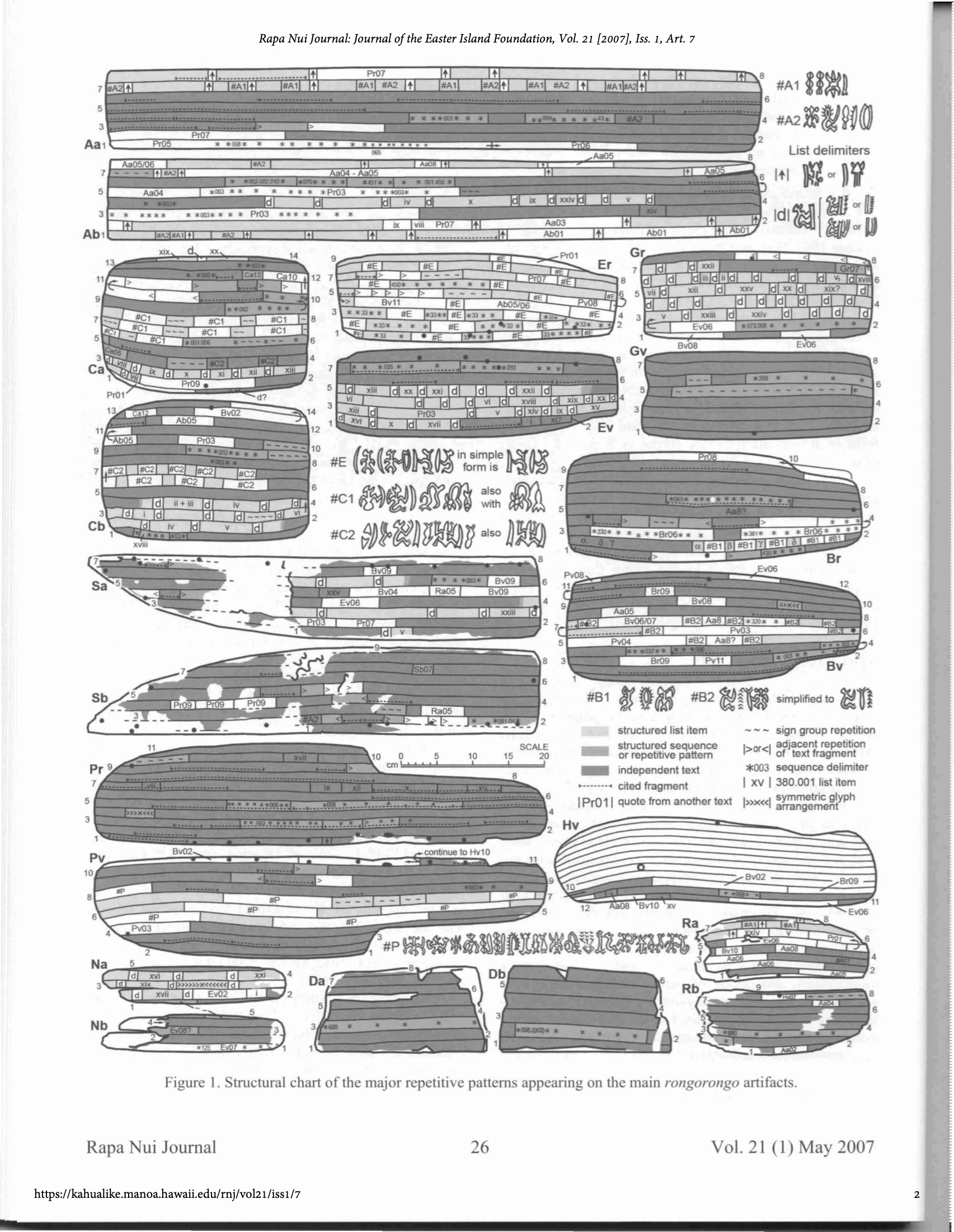Inventors
Writing is one of the pillars on which modern civilization stands. Although we perceive it as a natural part of our daily life, it was once invented. This happened only a few times, the article will focus on just one of such cases - the writing of Easter Island, also called Rapa Nui. This is a small secluded island 24 kilometers long, to the nearest inhabited island you can sail 1600 kilometers in a straight line from it. Polynesian sailors got there in about 1200, and Europeans knew it in 1722. Europeans were impressed by hundreds of stone statues created by the islanders, up to 10 meters high and up to 80 tons of weight each. In this, Rapa Nui differed from all other Polynesian islands, on which, if stone statues were made, they were of very modest size. Despite this,Europeans treated the local population like savages: they caught them and sold them into slavery, seized their land, turned the entire island into a pasture, and finally converted the survivors to Christianity, forbidding them to speak their native language and reproduce the local culture.
Opening
In 1864, the missionary Ayrault made an amazing discovery: in almost every hut there were small tablets covered with fine carvings, which seemed to be readable until all the literate islanders died in slavery. We do not know exactly what happened, apparently, Eiro declared the tablets forbidden, preventing entry to heaven and urged them to burn. In addition to Christianity, Eiro brought tuberculosis to the island, an epidemic of which wiped out a quarter of the population in a few years. After his death in 1868, another priest who replaced Eiro, nevertheless decided to tell the authorities about the tablets. Bishop Jossan in Tahiti immediately understood the significance of the find, but by that time there were only two dozen artifacts with inscriptions. So the world learned about rongo-rongo - the writing of Easter Island.

Remaining
The tablets were preserved by chance: some of them were not given to Eiro by the locals, and some were buried in damp caves with family values, from where they were later pulled out for sale. Due to the dampness, many of them are badly damaged and archaeologists, most likely, will never find other tablets, they simply rotted in caves. In total, we know about 28 texts , some of which may be fakes. In total, about 14,000 characters were identified on them. Today the tablets are kept in museums all over the world, in Russia two of them can be seen in the Kunstkamera.
The texts were carved into tablets, driftwood, figurines and wooden ornaments using an obsidian blade and a shark's tooth. According to the results of the analysis of bottom sediments of the lakes, until 1200, Rapa Nui was covered with dense forest, but with the arrival of man, the trees began to give way, so that by the time of the European visit there was not a single plant higher than a few meters. It seems that the Rapanui cut down all their trees, were unable to build a large ocean canoe to sail for help to other islands, and remained isolated, plunged into civil war, hunger and cannibalism. So the plaques were carved on what would have to be: stocks of old wood, European oars, crosses erected in 1770 by the Spaniards, and even on the wreckage washed by the waves to the coast. Radiocarbon analysis shows that some of the tablets are carved into wood,grown on the island before European contact, but we do not know when exactly the carving was made.
Study of
An unknown written language in the 19th century could not fail to attract the attention of scientists, attempts to read the texts began immediately after their discovery. It was natural to assume that someone could still read rongo-rongo, or at least saw how it was done. Bishop Jossan found an emigrant from Easter Island in Tahiti and tried with his help to read them and compile a catalog of signs. In response, he received several chants, reproduced from memory, and as readings of the signs - their description as if they were just pictures: here is a turtle, here is a plant, here is a man, and this is a bird ... Jossan's informant did not really know how to read texts. Then there were several more attempts to find other informants, but as time went on, the generation, which found the times before the raids of slave owners, grew old and lived out their days in a leper colony... Together with the last of them, the opportunity to learn something about the reading of rongo-rongo from eyewitnesses was exhausted. Realizing that the Europeans were interested in rongo-rongo, the Rapanui began to make fake tablets, as well as create hoaxes in the form of secret manuscripts, supposedly containing decryption keys. Unfortunately, there was not a single real key or bilingual among them, so it's time to use other approaches to decryption.
Parallel fragments
The first serious result was obtained by Leningrad schoolchildren Boris Kudryavtsev, Valery Baitman and Alexander Zhamoida in 1938. They found that on both tablets in the Kunstkamera approximately the same text was written. Later, Kudryavtsev discovered that there was another repeating fragment on two tablets from other museums. He also compiled his own catalog of rongo-rongo signs. Kudryavtsev died in the war, but years later his work was continued by Yuri Knorozov, by that time had already deciphered the writing of the Maya. He created a special group for decoding rongo-rongo, which approached the issue on a grand scale, created new catalogs of signs and even used computers, but all these efforts brought little results. Now it is difficult to judge what exactly caused the failure, but, apparently, three factors can be distinguished:
- Knorozov worked mainly with photographs, and not with the originals of the texts, so his group was unable to compile an adequate catalog of signs.
- Knorozov's success in deciphering the Mayan writing, the principles of which he completely transferred to rongo-rongo.
- None of his group at that time knew Rapanui or at least some kindred Polynesian language.
Rongo-rongo was declared not a real writing, but a mnemonic rebus, in which the "service parts of speech" were skipped, leaving the broadest scope for creativity. Now we know, for example, that in the Rapanui language there are not even parts of speech in our usual sense, most words can be nouns or verbs, depending on the "service parts of speech" around them, so nothing without these small words-suffixes and prefixes I probably wouldn't have read it.
Catalog of signs
Around the same years, Thomas Bartel travels the world, makes copies of all known tablets using a pencil and tissue paper, and uses them to create his own catalog of rongo-rongo symbols . Researchers still use it. Unlike Knorozov's group, Bartel drew attention to the fact that individual signs have elements repeating in different combinations, this observation formed the basis for the classification. He managed to identify about 700 unique signs, grouped by the shape of bodies, heads, arms, legs and other elements. Barthel's catalog has allowed other scientists to move from purely verbal descriptions of signs "man with a raised pen" to reliable digital codes. Barthel's follower Stephen Fisher made copies of the tablets anew and corrected the errors found, and the unification continued to correct the catalog.CEIPP - you can write to them and ask to send a text file in which the entire body of texts is encoded.
The elements
In the 1980s-90s, Guy, Makri and Pozdnyakov, studying parallel fragments of texts, expanded our understanding of the internal structure of individual signs. It turns out that many of the elements are, as it were, allographs - different spellings. The catalog of constituent elements is decreasing and a hypothesis about the syllable character of rongo-rongo appears. In the Rapanui language, 55 syllables and 55 elements with allographs seem to be enough to encode almost the entire corpus of existing inscriptions.
Here is a table of Pozdnyakov's basic elements:

The advent of personal computers made it possible to install hundreds of parallel fragmentsof various lengths, as well as enumerations and other structured parts - I will provide links to some of the articles describing individual results below. Here is the structure of the texts of some of the tablets relative to each other:

Horley also proposed his own catalog of the constituent elements of the signs.

Decryption
Until now, one might get the impression that there were no attempts to propose a transcript, but instead, scientists scrupulously examined the texts and drew cautious conclusions. Everything was different, the most varied decryptions were offered! "Readings" in American Indian languages were offered, it was stated that rongo-rongo is the script of the Indus Valley, that the Rapanui are Incas or even Aryans. Irina Konstantinovna Fedorova, a former member of the Knorozov group, in the 1990s proposed her own interpretation, according to which the texts tell about agriculture: how who sowed and reaped what kind of potatoes. De Laat has all the texts about a man who killed his wife. Ryabchikov's - about astronomy. In Fischer - about the emergence of things from other things ...
Modernity
So, with the hypothesis of the syllabic nature of the writing and a large number of parallel fragments, we seem to have arrived at the problem of decoding the homophonic substitution . It is necessary to translate the Barthel codes into a new encoding with fewer component elements of signs, to disassemble the corpus of surviving Rapanui legends and traditions by syllables and then apply one of the algorithms that have appeared in recent years. What's in the way?
1. We do not know exactly how to correctly divide the symbols of the Barthel catalog into their component parts. Note that Pozdnyakov and Horley have significantly different sets of building blocks and none of them has ever published the coding of texts into their own systems. Algorithms for decoding homophonic replacement allow us to leave about 150 homophones (three times more than the number of syllables in Rapanui), but we cannot say what is significant and what is not.
2. Low availability of corpora and dictionaries of the language. Fuentes' most complete dictionary , apparently, has never been leaked to the public. In paper form, it is a bibliographic rarity. Legendary records made by anthropologists such as Metro or Routledge have not been published and are still preserved in the archives of their expeditions in the form of manuscripts.
3. Incorrect spelling of most sources. In Rapanui there is one phoneme, a glottal stop, a sound in place of "-" in Russian "not-a". She was first heard over two hundred years after the first contact. Fuentes and Englert celebrated it here and there, but now we know that it is not everywhere. It is absurd, but the famous Soviet researcher Irina Fedorova in her publications generally skipped it, "for reasons of convenience when typing", which for the Russian language would be equivalent to skipping the letters "t" and "s". This is important because the algorithms for decoding homophonic substitution use the frequencies of individual elements, usually n-grams.
4. After raids by slave traders, the Rapanui language was very strongly influenced by other Polynesian languages, primarily Tahitian and Mangarevian. They are about as close to Rapanui as Serbian is to Russian, which led to extensive borrowing. The first even somewhat large dictionaries were compiled after the wave of borrowing occurred. And, although this does not mean that the Rapanui people spoke some completely different language, the changes cannot be ignored.
What to read
About the history of the island:
Contemporary view
About contacts with the American Indians
About rongo-rongo:
Bartel: 1 , 2
Davletshin: 1 , 2 , 3 , 4 , 5 , 6
Guy: 1 , 2 , 3 , 4
Harris: 1
Horley: 1 , 2 , 3 , 4 , 5 , 6 , 7
Knoros: 1
Macri: 1
Chalk:1 , 2 , 3 , 4 , 5 , 6
Pozdnyakov: 1 , 2 , 3 , 4 , 5 , 6
Fedorova: 1 , 2
Vetshorek: 1 , 2
About algorithms for decoding homophonic substitution:
Kopal: Cryptanalysis of Homophonic Substitution Ciphers Using Simulated Annealing with Fixed Temperature
Dhavari: Efficient Cryptanalysis of Homophonic Substitution Ciphers
Magnuson: Homophonic Cipher Attack
Campos:Genetic Algorithms and Mathematical Programming to Crack the Spanish Strip Cipher
Sanguino: Analyzing the Spanish Strip Cipher by Combining Combinatorial and Statistical Methods
Oranchak: Evolutionary Algorithm for Decryption of Monoalphabetic Homophonic Substitution Ciphers Encoded as Constraint Satisfaction Problems
Ravi: Bayesian Inhersiac
King: An algorithmic solution of sequential homophonic ciphers - a little about a different kind of ciphers, but with an interesting idea
AZdecrypt
Zhong: Cryptanalysis of Homophonic Substitution Cipher Using Hidden Markov Models
Nuhn: Beam Search for Solving Substitution Ciphers
Nuhn: Improved Decipherment of Homophonic Ciphers
Kambhatla: Decipherment of Substitution Ciphers with Neural Language Models
About Rapanui:
Grammar of Du Feu
Grammar of Kieviet -
Englert's most detailed Dictionary
Comparative Dictionary of Polynesian Languages
Corpus of Rapanui texts by Kozmin , who suddenly died on the
second Kozmin's corps associates
Third corps of Kozmin
Inspirational, in Russian:
Aku-aku Tura Heyerdahl
Myths and legends of Easter Island Fedorova
Myths, traditions and legends of Easter Island Fedorova Is a different book, although the titles are similar
Afterword
Easter Island culture piqued my interest at the age of 11 when I read Thor Heyerdahl Aku-aku's book. Then the island seemed incredibly distant and unusual, on the opposite end of the world. Now the distances have decreased, you can read dozens of books and articles about the island, talk to modern Rapanui people, but rongo-rongo is still a mystery.
The problem is waiting for its solution!